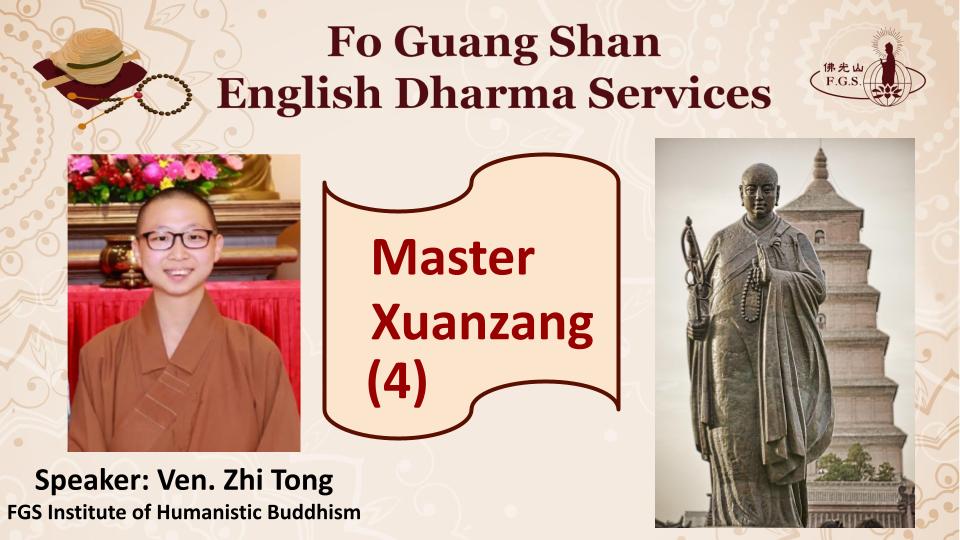
Speaker: Ven. Zhi Tong
Fo Guang Shan Institute of Humanistic Buddhism
I. Introduction
Auspicious greetings! Welcome to the fourth and final episode of the biography of Master Xuanzang. Last week, we met with Master Xuanzang’s teacher, participated in the great debate, and returned to China along with Master Xuanzang. This week, we will learn how Master Xuanzang conduct his translation court, as well as the legacy that he left behind.
II. Presiding a Translation Court
To Master Xuanzang, the priority now was to the translation of Buddhist text. He stated to the emperor that he had brought back over six hundred Sanskrit texts, and asked permission to begin translation. The emperor agreed and decreed that Master Xuanzang could translate in the royal temples, located in the capital city. Twelve monks of great learning were brought to the temple to assist with the translation, as well as scribes and copyists. Finally, in the year 645, when Master Xuanzang was about 44 years old, he began to translate.
In just the first year, Master Xuanzang translated five texts that totaled to fifty-eight fascicles. He respectfully asked the emperor to write a preface for the translation, which was granted. This was the renowned Great Tang Dynasty Preface to the Holy Teachings of the Tripitaka, written personally by the emperor.
In his interactions with the emperor, whether written or in person, Master Xuanzang was deferential but held himself elegantly and scholarly. The emperor quite admired this Buddhist master, and even asked Master Xuanzang to consider disrobing and join the ministry. Master Xuanzang was not moved. He said,
“How can I, a humble, mediocre man, be competent to participate in political affairs? I wish to observe the precepts as a monk and spread the Dharma. I pleaded with your majesty not to press me to change my mind till the end of my life.”
The emperor was pleased, and dropped the subject.
How did Master Xuanzang translate? It is not a one-man work. Instead, he had a team of people, each had their own specialized area.
Before the day’s work began, a Dharma service was conducted to maintain the solemnity of the day’s work. As the chief translator, Master Xuanzang would read out the Sanskrit text that was going to be translated, and explained its meaning. Scribes proficient in Sanskrit would note down his explanation. Next, several rounds of proofreadings took place to make sure that the Chinese translation presented the same meaning as the Sanskrit text. Additionally, the Chinese translation is edited for readability and fluency. The final translation must be proofread for any mistakes before it was approved. Whenever a text was fully translated and approved, it would be copied by scribes and distributed to temples throughout the country.
One of the reasons attributed to the success of Master Xuanzang’s translation career was support from the emperor. Without royal patronage, it would be more challenging to find a place to translate, as well as human and material resources required for such a monumental task.
Did Master Xuanzang have rules for translation? Yes, he did. Master Xuanzang held the theory of the Five Untranslatables, or five instances where one should transliterate the Sanskrit instead of translate it, and they are:
- If the Sanskrit is Dharanis or mantras.
- If the Sanskrit term has too many definitions and meaning.
- If the Sanskrit term refers to something that cannot be found in China, for example, trees or plants that are native in India but does not grow in China.
- If the Sanskrit term is already popularly known, in this case Master Xuanzang would defer to the past.
- If the Sanskrit term can inspire respect and righteousness in the reader.
How did Master Xuanzang spend his day? It was recorded that he made a timetable for himself. And if he did not complete his work because of the interference of some business or other in the daytime, he would finish it at night. Master Xuanzang would only stop working after 9P.M., and when he had put aside the Buddhist texts, he would worship the Buddha’s image as until 10 P.M., and then sleep until 2A.M., where he would get up to read the Sanskrit texts and mark out with red ink the paragraphs he would translate the following day.
Moreover, Master Xuanzang would give two lectures a day, as well as busy consulting with over a hundred students and foreign visitors and supervising eunuchs from the palace who came with orders for scriptures and images.
As can be seen, there was not a moment’s rest in Master Xuanzang’s day. It was estimated that Master Xuanzang and his team translated, on an average, seventy fascicles a year. But slowly, as flowers blossom and wilt, Master Xuanzang experienced old age and sickness. The hardships of his travel had left indelible marks on his physical body, for he fell gravely ill when he was 54 years old. Though he recovered from his illness, he knew time was pressing.
When he was fifty-eight years old, Master Xuanzang began the monumental translation of the Perfection of Wisdom Sutra. The original Sanskrit text consisted of two hundred thousand verses, and only parts of it had been translated into Chinese. In the beginning, Master Xuanzang’s disciples wished to produce an abridged version, given the immense length of the text, which Master Xuanzang agreed. But after deep consideration, Master Xuanzang decided to translate the text exactly as it is. He compared the three Sanskrit versions that he brought back from India, and made attentive research before translating the words into Chinese. When he came to dubious passages or mistaken points in the text, it was as if his wisdom eye was opened, and he could resolve these problems. Master Xuanzang attributed the merit to the buddhas and bodhisattvas.
While he was translating the Perfection of Wisdom Sutra, Master Xuanzang feared that he might die before he could finish, but in three years, the monumental task was completed. The final translation was a 600-fascicle text. Upon completion, Master Xuanzang joined his palms together with exhilaration, and said to his disciples,
“This sutra has a special relationship with the land of the Han people… It is with the spiritual assistance of the Buddhas and under the protection of the dragons and deities that I have completed the task. As this is a text that will guard the nation and a great treasure of men and heavenly beings, you all should rejoice and be glad at its completion.”
After the completion of the Perfection of Wisdom Sutra, Master Xuanzang felt physically exhausted. He knew that his time on earth had drawn to an end.
III. Death and Legacy
When Master Xuanzang completed the translation ofPerfection of Wisdom Sutra, he said to his disciples, “I have now completed the affair concerning the sutra, my career has also come to an end. After my death, you should manage my funeral in a simple and frugal way. You may just wrap my body in a coarse bamboo mat and dispose of it in some quiet corner of the mountains. Do not put it near the palace or any monastery. The impure body should be discarded far away.”
The disciples were shocked by the master’s words, and wept. They begged him to translate another sutra. However, after translating only a few lines, Master Xuanzang knew that there was no way he could accomplish the translation, and he put down his translation brush for the final time, since he had begun nineteen years ago. He did not do any further translation.
In his last days, Master Xuanzang asked his disciples to write down the deeds he had done in his life, and they were:
- Translated 74 texts, totalling 1338 fascicles
- Painted the pictures of the bodhisattvas Bhrkuti and Maitreya each 1000 times
- Transcribed the Diamond Sutra and the Medicine Buddha Sutra, as well as other sutras, each 1000 times
- Given alms to more than 10,000 poor peoples
- Made offerings to more than 10,000 monks
- Lighted hundreds and thousands of lamps
- Redeemed the lives of tens of thousands of living creatures
Master Xuanzang passed away in peace at the age of sixty-one years old. When the news of his death reached the emperor, he sighed and said, “We have lost a national treasure.” For his funeral, more than 1 million people attended. Master Xuanzang’s will was kept, and he was placed in a bamboo-mat hearse and buried in a quiet place by the side of a mountain, far away from palaces or monasteries.
Master Xuanzang was one of the greatest and most honored Buddhist masters.
- As a monastic, he was faithful to the Triple Gem, and upheld the precepts strictly. He was steadfast in his task to learn the Dharma and propagate it.
- As a diplomat, his pure conduct and wisdom gained recognition and support from the kings of India and the emperors of China. He enabled cultural exchanges between great civilizations and cultures. Moreover, no matter where he went, he elevated the social status of Buddhism.
- As an traveller and explorer, he had trekked over 10,000 miles, across hundreds of countries, leaving behind a precious account on the Western Regions and on India that are used as historical evidence for archaeological and art discoveries, even until today.
- As a translator, he brought upon a new way of translating Buddhist texts into Sanskrit, so that texts that were translated before him were known as “Old Translations,” and texts that were translated by him and onwards were known as “New Translations.”
- He was also the founder of a new Buddhist school, the Faxiang School, which flourished all the way from China to Japan.
VI. Conclusion
There is so much more to be said about Master Xuanzang, and I have only scratched the surface. No matter if you take Master Xuanzang as a Buddhist master, an explorer, a diplomat, or a translator, we can learn from his perseverance, diligence, compassion, and wisdom.
Here I shall put an end to the biography of Master Xuanzang. I hope you find the life and legacy of this eminent Buddhist master as inspiring as I did. Thank you for listening to this Dharma talk. If you like to receive more English Dharma contents, be sure to like and subscribe. See you next week. Omitofo.

